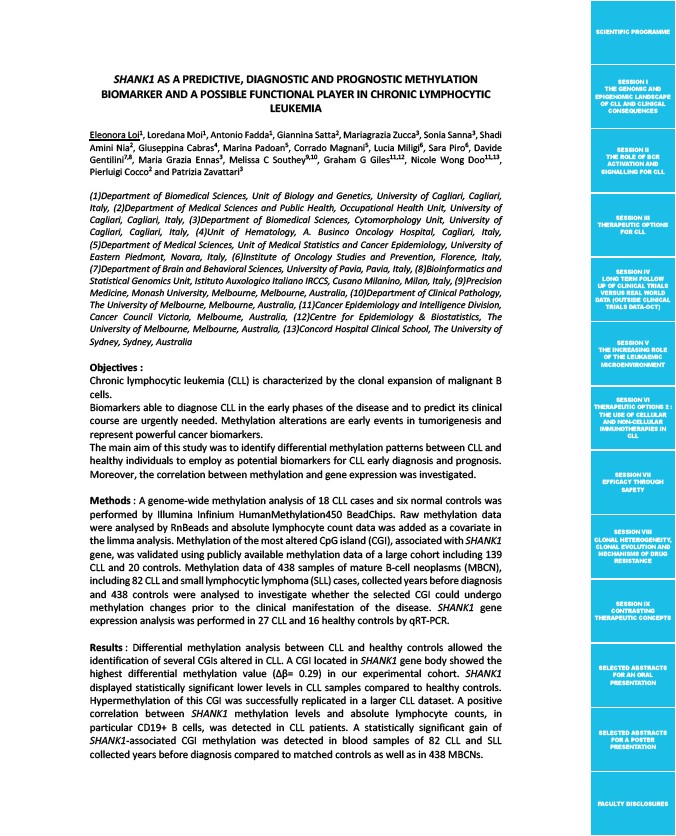
SCIENTIFIC PROGRAMME
SESSION I
THE GENOMIC AND
EPIGENOMIC LANDSCAPE
OF CLL AND CLINICAL
CONSEQUENCES
SESSION II
THE ROLE OF BCR
ACTIVATION AND
SIGNALLING FOR CLL
SESSION III
THERAPEUTIC OPTIONS
FOR CLL
SESSION IV
LONG TERM FOLLOW
UP OF CLINICAL TRIALS
VERSUS REAL WORLD
DATA (OUTSIDE CLINICAL
TRIALS DATA-OCT)
SESSION V
THE INCREASING ROLE
OF THE LEUKAEMIC
MICROENVIRONMENT
SESSION VI
THERAPEUTIC OPTIONS 2 :
THE USE OF CELLULAR
AND NON-CELLULAR
IMMUNOTHERAPIES IN
CLL
SESSION VII
EFFICACY THROUGH
SAFETY
SESSION VIII
CLONAL HETEROGENEITY,
CLONAL EVOLUTION AND
MECHANISMS OF DRUG
RESISTANCE
SESSION IX
CONTRASTING
THERAPEUTIC CONCEPTS
SELECTED ABSTRACTS
FOR AN ORAL
PRESENTATION
SELECTED ABSTRACTS
FOR A POSTER
PRESENTATION
FACULTY DISCLOSURES
SHANK1 AS A PREDICTIVE, DIAGNOSTIC AND PROGNOSTIC METHYLATION
BIOMARKER AND A POSSIBLE FUNCTIONAL PLAYER IN CHRONIC LYMPHOCYTIC
LEUKEMIA
Eleonora Loi1, Loredana Moi1, Antonio Fadda1, Giannina Satta2, Mariagrazia Zucca3, Sonia Sanna3, Shadi
Amini Nia2, Giuseppina Cabras4, Marina Padoan5, Corrado Magnani5, Lucia Miligi6, Sara Piro6, Davide
Gentilini7,8, Maria Grazia Ennas3, Melissa C Southey9,10, Graham G Giles11,12, Nicole Wong Doo11,13,
Pierluigi Cocco2 and Patrizia Zavattari3
(1)Department of Biomedical Sciences, Unit of Biology and Genetics, University of Cagliari, Cagliari,
Italy, (2)Department of Medical Sciences and Public Health, Occupational Health Unit, University of
Cagliari, Cagliari, Italy, (3)Department of Biomedical Sciences, Cytomorphology Unit, University of
Cagliari, Cagliari, Italy, (4)Unit of Hematology, A. Businco Oncology Hospital, Cagliari, Italy,
(5)Department of Medical Sciences, Unit of Medical Statistics and Cancer Epidemiology, University of
Eastern Piedmont, Novara, Italy, (6)Institute of Oncology Studies and Prevention, Florence, Italy,
(7)Department of Brain and Behavioral Sciences, University of Pavia, Pavia, Italy, (8)Bioinformatics and
Statistical Genomics Unit, Istituto Auxologico Italiano IRCCS, Cusano Milanino, Milan, Italy, (9)Precision
Medicine, Monash University, Melbourne, Melbourne, Australia, (10)Department of Clinical Pathology,
The University of Melbourne, Melbourne, Australia, (11)Cancer Epidemiology and Intelligence Division,
Cancer Council Victoria, Melbourne, Australia, (12)Centre for Epidemiology & Biostatistics, The
University of Melbourne, Melbourne, Australia, (13)Concord Hospital Clinical School, The University of
Sydney, Sydney, Australia
Objectives :
Chronic lymphocytic leukemia (CLL) is characterized by the clonal expansion of malignant B
cells.
Biomarkers able to diagnose CLL in the early phases of the disease and to predict its clinical
course are urgently needed. Methylation alterations are early events in tumorigenesis and
represent powerful cancer biomarkers.
The main aim of this study was to identify differential methylation patterns between CLL and
healthy individuals to employ as potential biomarkers for CLL early diagnosis and prognosis.
Moreover, the correlation between methylation and gene expression was investigated.
Methods : A genome-wide methylation analysis of 18 CLL cases and six normal controls was
performed by Illumina Infinium HumanMethylation450 BeadChips. Raw methylation data
were analysed by RnBeads and absolute lymphocyte count data was added as a covariate in
the limma analysis. Methylation of the most altered CpG island (CGI), associated with SHANK1
gene, was validated using publicly available methylation data of a large cohort including 139
CLL and 20 controls. Methylation data of 438 samples of mature B-cell neoplasms (MBCN),
including 82 CLL and small lymphocytic lymphoma (SLL) cases, collected years before diagnosis
and 438 controls were analysed to investigate whether the selected CGI could undergo
methylation changes prior to the clinical manifestation of the disease. SHANK1 gene
expression analysis was performed in 27 CLL and 16 healthy controls by qRT-PCR.
Results : Differential methylation analysis between CLL and healthy controls allowed the
identification of several CGIs altered in CLL. A CGI located in SHANK1 gene body showed the
highest differential methylation value (Δβ= 0.29) in our experimental cohort. SHANK1
displayed statistically significant lower levels in CLL samples compared to healthy controls.
Hypermethylation of this CGI was successfully replicated in a larger CLL dataset. A positive
correlation between SHANK1 methylation levels and absolute lymphocyte counts, in
particular CD19+ B cells, was detected in CLL patients. A statistically significant gain of
SHANK1-associated CGI methylation was detected in blood samples of 82 CLL and SLL
collected years before diagnosis compared to matched controls as well as in 438 MBCNs.